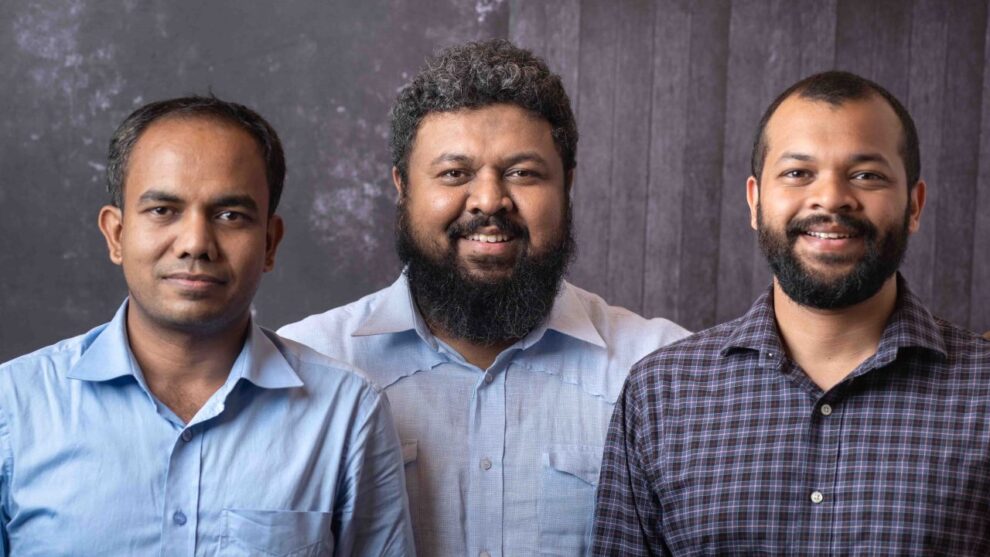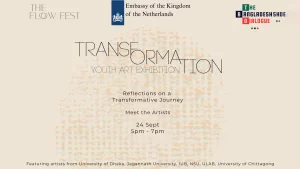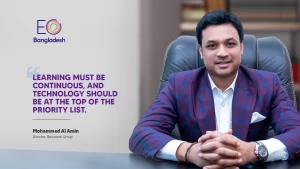1. Tell us about yourself. What was your motivation behind Tanguar Racing?
I’m Tauseef Anwar and I’m one of the co-founders of Tanguar Racing. I studied economics but ever since I graduated, I have been working in the technology field, especially in the software sector, and more recently, on anything that involves high tech engineering.
Our team Tanguar Racing is essentially built to develop electric motorsport vehicles in Bangladesh. There is a demand for sustainable transportation in the whole world, with the engineering and innovation already taken care of. But the implementation and awareness amongst different regions and consumer groups are still needed. And in Bangladesh, as most of us already know, we have a major traffic issue in our cities. With that, there is also the issue of pollution and energy-waste because we are importing fuel and burning our own natural gases very inefficiently. All of this motivated us to build a team that is going to develop electric vehicle technology in Bangladesh.
But any automobile enthusiast will tell you that when you are trying to develop an electric vehicle, whatever the size is, one of the best ways to test your innovation is to put it in a very extreme test. And there is no other extreme test than motorsports.
Globally there are many different types of motorsports, there are Formula Open Wheel Racing, Rally, Endurance Racing, Off-Track and On-Track racing, and a lot of different categories within those race types. We believe that if we can build an electric vehicle and put it on those different competitions, we can start developing the technology in Bangladesh.
We are not only focusing on electric vehicles but also on sustainable electric vehicles such as solar electric vehicles.

2. How did the journey of Tanguar Racing start?
There were actually a couple of inspirational points – all happening at the same time.
In late 2014, the first-ever global electric racing competition, called Formula Electric, started to take place. That is what personally inspired me to start pursuing a venture that may one day participate in such a competition. It takes a lot of time to develop a reputable organization to compete in those global competitions, so while we can’t do it today, we maybe can in 10 years.
At the same time, my teammates were all individually working on electric vehicles on their own. One was doing it for his business, the other was doing it for research, and I was doing it to participate in competitions. I actually knew my teammates, Ahmad, and Gopal, for a while. And we decided that since we are all trying to do the same thing, why don’t we just bring ourselves together and figure it out?
You have to understand that in Bangladesh, we don’t have motorsports, and so we needed an outlet where we knew people like us can participate. In late 2015 a competition called ‘The 80 Day Race’ was announced that was organized by a group from the Netherlands. It was open for anybody as long as they can bring a vehicle that they can drive and race with. That gave us an opportunity to think about forming a team and that is when we officially created Tanguar Racing.
The word ‘Tanguar’ came from the famous water body of Bangladesh, called Tanguar Haor. And we used that name to symbolize the environment and eco-system in Bangladesh as we wanted to portray the country on a global platform.
3. Tell us about the electric motor racing and what type of racing competition it is.
The first international event that took place in the world, as I have said before, was Formula Electric in 2014. There were no other official events before that and now the event is in its’ sixth season. That is like the ultimate competition and the most important one, and since it started, other people started organizing different smaller events in different categories as well.
So, Formula Electric is the formula grade open-wheel racing which happens on street circuits. This means they build a racing track within cities like London, Berlin, Hong Kong, and in a lot of other major cities in the world. These teams are from different manufacturers and bring in the cars that they designed themselves to participate in the race. A lot of professional racers also participate as drivers. That is our target which we hope to reach in the next 10 years. But obviously we have to develop ourselves in terms of experience, finance, and reputation as well. You can’t just enter the competition on your own, you have to have a little bit of credential.
And now there are other competitions inspired by that. The first one is the one I mentioned earlier – The 80 Day Race. This is actually not a track racing competition; it is adventure-endurance racing where the goal is to build and drive a non-fossil fuel vehicle. It cannot have any petrol, gas, or diesel, but it can run on electricity, on hydrogen, or any other renewable technology that we can invent. And we have to drive it around the world, which is around 35,000 km at least, in less than 80 days. It was inspired by Jules Verne’s Novel “Around the World in 80 Days”, and the winner is whoever can complete travelling the 35,000 km in less than 80 days.
This is the only adventure-endurance competition for electric vehicles and amateur teams that is being organized in the world. And it is huge as there are going to be competitors from the US, UK, France, India, and of course, we are participating as Team Bangladesh. We are going to be driving for more than 2 months continuously, travelling through Europe, Asia, China, and North America.
Some more competitions are coming up. For example, Extreme E, where only electric vehicles will be run. That competition highlights different elements, like sand, ice, mountains, jungles, as well as very different and extreme environmental conditions. It is being organized to promote environmental sustainability and awareness about the effects of climate change on the natural world. Six teams participate in that competition and we want to be one of those teams maybe in about 5 years, hopefully, if everything goes well.
Also, there is another race, called the ERA Championship, which will start from Belgium, and will also take place in Netherlands and the UK. It’s being organized by a team in Belgium and is the first ever Formula 4 category racing only for electric vehicles. We are actually investing in a vehicle which will probably be the first Formula grade vehicle that any Bangladeshi organization will be owning and running.
Formula 1 is the highest category, then there is Formula 2, then Formula 3 and so finally Formula 4. Formula 4 is considered a junior entry, which is mostly for amateur racers. We are entering as an amateur team because it’s the only formula electric vehicle race after Formula E. It gives us a very big platform to develop ourselves. Hopefully, we can enter the ERA Championship in about 3 years from now and we will be the first-ever Bangladeshi team to enter Formula Racing.

4. Briefly tell us about the ongoing activities and tell us about the upcoming projects of Tanguar Racing. Is there any plan for global expansion?
There are two races that we are participating in, and we are preparing for them both at the moment. Our goal is to participate in Formula Electric in 10 years. If we can before then, it’d be even better, but our target is to attend it in 2030. And before that, we want to build a reputation.
Our first goal is to participate in the 80 Day Race, which is going to take place in 2022 around summer. We hope to be the first-ever team in the world, not just from Bangladesh, to complete the 35,000km journey in less than 80 days with a solar electric vehicle. We are very actively working on it, and a lot of planning is going on in terms of developing the vehicle. I think we are also the only team that is actually building a vehicle from scratch for this event whereas the other teams are just buying it from the market.
And in 2023, we are going to put a team in the ERA Championship, which is the Formula 4 electric racing. These are the two main projects we are building up to. We are training ourselves, raising funds, and doing team-planning and deployment-planning for how we are going to participate in the race. Europe already has one or two experienced teams, but our team has never done this before. So, this is something that is going to be completely brand new for us.
And the third venture is something that we’ll hopefully start by the end of this year. If you have been following online gaming, you’d know that it has become very big, especially during this whole COVID period. No global sports could take place and so all the participants and athletes actually moved to the virtual platform. And the same thing has happened in motor racing. Since we have missed some major competitions held in the last 6 months, we don’t want to miss any more of them in the future, and so we are preparing to participate in virtual racing. Before the pandemic, these competitions were already there but weren’t so popular amongst general sports audiences. But now they’re booming and are becoming million-dollar industries. Because you don’t need to organize a physical race and everything is virtual, the costs are close to negligible compared to an actual race and people can watch from anywhere in the world on a computer, phone, or laptop. It has become huge and all the professional athletes are now entering that industry. So, what we are going to do is we will create a team, which we are already doing behind the scenes, and from November onwards we will start participating in the amateur online races. Maybe next year we will participate in the paid events where if you win the event you get prize money.
So, these are the three projects. And for our global expansion, because motor racing does not really exist in Bangladesh at the moment, everything we do will be on an international scale. We have no other opportunities and in fact, there isn’t even a regional event that countries like India, Nepal, Bangladesh, etc. are organizing together.
Some big news portals have covered The 80 Day Race event and has written about its teams from places like US, UK, France, and Bangladesh. It seems like a lot of the press are surprised that a Bangladeshi team will be participating. And because the effects of climate change are actually going to be much severe on a country like Bangladesh, there is a bigger mandate for people like us to present it on a global stage. They want people like us to come and talk about the effects of climate change, and these events and platforms are perfect to do that kind of advocacy.
5. Share some achievements of Tanguar Racing and how it is contributing to our society.
In preparation for the 80-Day Race, we have built a solar electric vehicle for the first time in Bangladesh, that runs on electrical energy assisted by solar power, and it is going to be road-legal anywhere in the world. The vehicle we create has technology that will help it sustain the pressure of driving 400km continuously every day. The technology that is being developed for that vehicle is going to be clean and sustainable, and this same technology will be eventually used for building solar electric vehicles for the general vehicle users of Bangladesh, by our parent company, Advanced Dynamics. We believe this effort is our biggest contribution to society.
One of our greatest achievements so far happened in 2019, when we drove a solar electric vehicle across Bangladesh for the first time in our country’s history. We had just completed building the first vehicle and were very happy with its performance. We decided that we were going to test it by driving it on real roads and show people what type of technology we’re capable of developing here in Bangladesh.
On 16th June of last year, we started driving from Teknaf, and in about 21 days, we were able to travel across 22 cities, which was roughly around 2000 km, without the car breaking down or any electricity issues. And this was the first time that any individual, team, or organization, had driven an electric vehicle across Bangladesh and that too a solar electric vehicle, for more than 2000km. There were so many variables stopping us, but we decided we should just go ahead and do it.
And because of that tour, this year we actually got a prestigious label from this organization called the Solar Impulse Foundation. It is a Swiss organization started by an adventure pilot named Bertrand Piccard. He is the individual who created a world record by flying the first-ever solar aircraft flight. He flew the solar aircraft around the whole world in 2015. He is actually one of our inspiration for the projects we are doing. His organization now gives out awards to different projects around the world that are building sustainable, environmentally friendly, and efficient technology. And not just to innovative ideas, but to actual projects that are financially feasible as well.
We got the award of the Solar Impulse Efficient Solution Label in April 2020; we are one of the few Bangladeshi companies that got the award. It is a huge thing in our industry to get this recognition on such a global scale. We had gone through 6 months of evaluation where they asked us detailed questions regarding our technology, our people, and our skills. Then, at the end of the day, they decided we are worthy of that award.
6. What inspired you to invent an environmentally feasible car and can you share some of the unique experiences of your test drives?
Answering the first part of the question, because we live in a country like Bangladesh which is so constrained in terms of natural resources, transportation is always a very big issue for us. We have to import fuel, our own natural gas is not sufficient for long-term use, and there’s a lot of inefficiencies in the transport sector. The way we are using our vehicles, and also due to traffic jam, we are burning away valuable fuel, energy and of course, that translates to money as well. And with that, we also see the effects of pollution in our city. We have been consistently getting worse and worse in terms of health indicators. The pollution is causing damage to not only us but to the future generation as well.
In 2019, there was a report about on a global medical research where they found black carbon pollutants in the lungs of an unborn baby due to air pollution. So, can you imagine what would happen to these babies when they grow up accumulating these pollutants in their vital organs? The future generation would grow up to become handicapped in terms of their physical abilities. And we will see these effects in about 10 or 15 years because it is already in a very bad state.
Because my team mates and I work in the engineering sector in one way or the other, we are always involved in pioneering different projects. We are always thinking about how to utilize our abilities and resources to find new solutions. And we realized that now is the right time to develop clean solar electric vehicles in Bangladesh, because there is a need for it and we believe that we can do it.
During our test drives there were so many unique experiences. The first thing that comes to my mind is something that I will always remember. When we were driving on the highways of Bangladesh, there were some places where buses were overtaking us. Some of the people in it who were slightly older, maybe in their 40s or 50s, they didn’t consider the vehicle to be something different and didn’t even look. But there were also some very young children and teengagers on some buses who always turned their heads and pointed at the car because nobody has ever seen a solar electric vehicle in Bangladesh before. You could easily tell that they were talking about the car. And we have seen this so many times in different regions – it has been fantastic to see that kind of response. It gives us hope that if we introduce something, it will be gladly accepted by the next generation.
Another incident that comes to mind is that there was this one place where we went to Habiganj in the Sylhet region. We had to meet with the local shop-owner who was arranging the vehicle’s charging for us. And I remember that when we went there, the moment we stopped in front of his shop, immediately everyone came out and they were looking at the car and asking us questions. We were prepared to take questions – it was one of the reasons why we wanted to go on this drive. But that day there were so many questions all around us, we got a bit overwhelmed that people were so interested in this new thing. It was really hard but a very pleasant experience. This is an electric vehicle that they’ve seen for the first time, and people are usually skeptical and everything, but not them. The amount of support that these people showed towards us as Bangladeshis, as innovators, I think, was tremendous.
And the final memory that I can share is when we went to a school in Brahmanbaria where we wanted to show this vehicle to young school children, to show them what can be built in Bangladesh. We gave a small speech over there but that wasn’t the exciting part because it was a very hot day and the children were standing in the heat. But when we finished, everybody, and we have photos of it, surrounded the car. They were even climbing on the car trying to see solar panels and everything, they were also trying to look into the car, but we didn’t let them inside the car. It was very exhilarating to see them very excited about new technology.

7. What were the challenges you faced initially?
I think because we were starting from scratch, the first challenge was being confident about the technology that we were working with. Because there are so many different aspects when you are building a vehicle and a certain time frame to be completed in, you feel challenged whether the approach you are taking is right or wrong. We are not that kind of a team where we hire a consultant from abroad, like from China or Japan. We did everything by ourselves using our local knowledge and local education – all our members are educated in Bangladesh. And so, overcoming those small challenges and slowly building our confidence was something that took us a while to achieve.
The second challenge is something that we are facing in great quantities even now. Any sport, motor-sport or any adventure that anybody does is driven by sponsorships. Unfortunately, whenever you try to do some new kind of media or try to build a new public project, it is very difficult to convince people to sponsor you, particularly in a country where sports is dominated by cricket, football, hockey, and badminton to some extent as well. Over here motor-sport is at the bottom of the pyramid and there is no understanding of the uniqueness of this sport. When we go to local sponsors, it is very hard for them because if, for example, they have a budget of 1 lac taka, they would rather spend it on printing posters than giving it to us for developing a very unique project that their brand can be associated with.
And the third challenge is related to motor-sport activity. Because we don’t have many activities here in Bangladesh, we don’t get to build something for local competitions. But hopefully in about 2-3 years, if an event happens in Bangladesh, we will be the first to say that we are building a car for that competition! But because it’s not currently happening locally, we have to think about everything in terms of different countries and regions. And for us, it means extra work and extra money to participate. For example, someone in Germany can very easily participate in a race in the Netherlands because it’s just a 4hr drive. But for us it’s like a whole month of planning to go and come back.
8. How do electric cars compare with hybrid cars? And besides the environmental-friendliness, what are the other benefits it ensures?
Hybrid vehicles were developed as an intermediate technology to transition from pure fossil fuel sources to cleaner combustions. So, in hybrids, for the majority of the time you are driving the car, you are burning fuel and only in the initial traction where you are just starting from zero is when the hybrid vehicles use electrical energy with no emissions. In 100% electric cars there are zero tailpipe emissions, which there are even when using hybrids.
If you consider the majority of vehicles being used in cities and if you consider the cities to be like closed boxes, you are essentially burning and putting out smoke in a closed box even with a hybrid vehicle. But the electric vehicles don’t do that, and when you are living in a city, nobody is exposed to immediate pollution when they get out of the houses or stand in their balconies.
I mean a hybrid doesn’t really help; it is a dead mechanism to us from a technological point of view – if you ask anybody in the world, they will tell you that it is over. It is something that I remember in our first press conference that a reporter asked us that, “Why aren’t you building a hybrid, that is a new technology?”, and we said, “No, that is a technology that was invented 20 years ago and is now dead”. If we have to invest money in creating technology, we are not going to rebuild old technology, we are going to make something that is going to be used 10 years from now. And that is why we are not just building electric vehicles, we are also building what we call “Regenerative Solar”. This means that when you’ll be stuck in traffic, the vehicle won’t only be burning any fuel at all, but it will actually be regenerating the energy from solar power and saving it in the battery. So instead of burning fuel, you are saving more fuel when you are in the street.
This is just the beginning of the technology and we are now generating 12% extra free mileage every time we are on the road. In about 3 years we believe that this will go up to 40%, which means that if you put in 100km worth of electricity in the vehicle, you get 40km extra for free. And, so, in about 2-3 years, you’ll see news on solar electric vehicles, and we’ll actually be one of the first 3-4 companies in the world that are building solar electric vehicles.
It is a very difficult industry, there’s a lot of big competitors, but we are trying our best and hopefully, we will find something sustainable.
9. Tell us about the features of your car. How do they operate?
Electric vehicles are very simple, and since we are manufacturing it for Bangladesh, we are not going to build any fancy features. For example, the benchmark of the global electric vehicle industry is Tesla, and Tesla has features like autonomous driving and has very nice internal ambient features. It also has a smart-computer on board in addition to the standard electric motor and battery. So, they have a lot of these interesting technologies in the car but what we are going to do is take a slightly different route because we have to think about the local market and price too.
Our primary technology will be completely running on a battery and that will power the electric motor. And our vehicle will have two kinds of electricity regeneration, at least in the beginning. One is from the braking – when you brake the vehicle, it will regenerate energy and store it back to the battery. Secondly, we have the solar aspect – whenever you are out on the road, your car will actually be charging. So, if you’ll be parked or driving, you’ll constantly be generating free energy.
In addition to that, we are also developing flood-proofing technology. You know how when it rains in Bangladesh, the streets get clogged and water gets into your car. So, we are trying to develop a technology to avoid that and hopefully we will be successful. We are also introducing biofilters in the car where 99.97% of harmful pollutants from the outside air will be trapped so that whoever is inside the car will be breathing very clean air even if the other cars are not electric.
So those are our basic features. Our vehicles will have top speeds of 140-150km/hr. It’s still a work in progress, but that is the target we are keeping.

10. What are the opportunities you are seeing for electric vehicles in Bangladesh?
There is a very big gap in consumer demand. Consumers are now spending a lot more on wasted energy than they should, just by traveling 2-3 km. And I feel that this is creating a problem in our whole energy, transport, and other industrial sectors. And I think that there is a very interesting gap here where electric vehicles can come in and give consumers a very cheap and affordable way of moving around. Everybody understands the impact of pollution and so I don’t think there will be any issue of acceptance.
And the other thing is that Bangladesh is a small country. So globally, when people are building electric vehicles, they are thinking about a 500 km range or 1000 km range. But our country is so small that if you travel 500km you will go to another country. So, you don’t need to develop very expensive and heavy cars with big and powerful batteries.
And finally, the one that we are banking on is that we have an immense amount of engineering talent that can enhance the sector even better than we can envision right now. Although electric vehicles are very complex in terms of maintenance, we don’t have problems finding people to build them, fix them, and to maintain them.
11. How can one reach out to Tanguar Racing?
We have a website called www.tanguarracing.com Then we have a Facebook page where we’re more active. It is facebook.com/tanguar.racing.
You’ll also find us on twitter at twitter.com/tanguarracing
So, we are very active everywhere, except on Instagram – we haven’t created an account yet.






